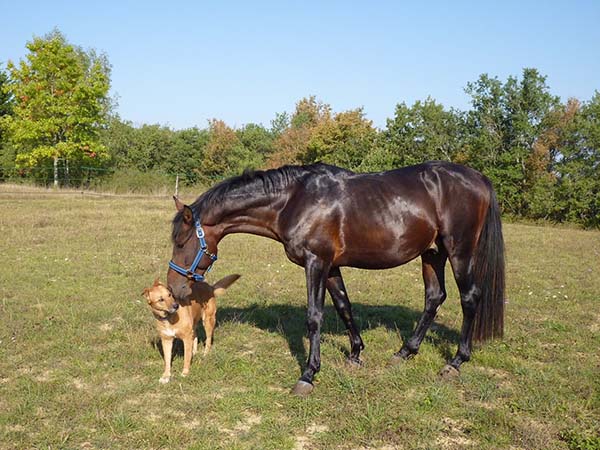Horseback Riding With Dogs: The Do’s and Don’ts

Horseback riding with dogs might seem like a no-brainer, but there are some things that you need to consider before you attempt it. If you’ve read my previous article about how horses get along with other animals, then you already know that horses and dogs make great companions. In order to ensure the safety of your horse, your dog, and yourself, you need to make some preparations before the journey.
The most important thing to consider when horseback riding with dogs is the way your horse and your dog interact with each other. Your horse and your dog need to feel comfortable and at ease in each other’s presence. They also need to be in decent physical condition, and they need to be able to obey your commands.
The ugly truth is that animals can be unpredictable. This could put them and yourself in danger, which is why you should always be prepared to take charge. I’m not saying to not enjoy your ride, but keep a watchful eye on both the horse and the dog just to be on the safe side.
Before we go into specifics on how to prepare for a horseback riding trip with your dog, here are the main do’s and don’ts for this unique activity:
- Make sure your horse and your dog are comfortable with each other.
- Familiarize yourself with the route beforehand.
- Make sure the horse and the dog are able to obey simple commands.
- Your horse needs to be able to spot your dog at all times.
- It’s always a good idea to bring a friend along that can help out the dog if the need arises.
- Go on short practice walks before attempting the real thing.
- Reward calm and positive behavior and make sure the animals are enjoying the walk as much as you are.
How to prepare for horseback riding with dogs.
You might think that your horse and your dog are completely comfortable around each other, but can you really say for sure? In order to be sure, you’ll need to go on a few practice runs, you’ll need to rehearse basic commands, and you might even go on a few short practice runs before embarking on a longer ride. Let’s walk through each of these steps together.
Introduce the dog to your horse.
Since you’ll be riding the horse and the dog will follow, you’ll have to make sure that the dog is on its best behavior around your horse. As you ride, you’ll have some control over your horse and you’ll be able to give it aids. With the dog, you’ll only be able to issue verbal commands. Introduce the dog to your horse gradually and take note of both of their reactions.
If everything goes well and both animals are calm, reward this behavior and repeat the process a few times just to be sure that they’re both friends with each other. However, if either the dog or the horse seems fearful or too excited, gradually put some distance between them and let them get used to each other’s presence from afar.
You can work on shortening this distance incrementally. Take note which animal is the most fearful or excited, though. If the horse is the problem, try to refocus its attention on you instead of the dog by using simple verbal commands. The horse needs to know that the dog is not a threat, but a companion.
Build on that relationship.
Once the two animals are accustomed to each other’s presence, it’s time to build on that relationship further. Just because your dog and your horse tolerate each other in a calm and controlled environment it doesn’t mean that they’ll behave the same while out on the trail.
Keep bringing your dog along with you as you take care of your horse. Bring it along as you give your horse water, as you brush it, or even as you take it out for groundwork.
The main concern is that your horse might kick or step on your dog by accident. Dogs are quite small when compared to horses, and if the horse is not always on the lookout for your dog, it might hurt it by accident. If your dog is particularly small, you might want to consider fitting it with a bell dog collar. Horses have good vision, though, and they’re more than capable of detecting your dog’s presence even without a sound stimulus.
Another thing you’ll want to work on is getting your dog and horse to trust each other. Like any relationship, this is done in time, so don’t rush into things and don’t expect to see results overnight.
Master basic commands.
The tricky part about horseback riding with dogs at your side is that you’ll need to be in charge of both your horse and your dog at the same time. In order for this to go smoothly, you’ll need to make sure that both animals are able to obey simple commands.
In the dog’s case, it should be able to follow the basics: sit, stay, come. The dog will likely follow your horse from a safe distance, or it might walk alongside it. I wouldn’t recommend having the dog running in front of the horse too much, as it might stop suddenly, become distracted, or make sudden noises that could spook the horse.
As for the horse, it should stop, turn, and walk on command without delay. Moreover, the more desensitized your horse is the better, as it won’t react unpredictably to uncomfortable situations or sudden noises.
Go on practice runs.

You can and you should go on shorter walks before attempting the real thing. This will give you an idea of what to expect, and it will also give you an opportunity to analyze your horse’s behavior around your dog and vice versa. You can start by leading your horse with a lead rope and having your dog follow from the side.
The dog is not the one being led here, so it is the most likely to “break formation.” Issue verbal commands and have it move calmly alongside your horse. Reward its behavior, and the horse’s as well.
Once you feel confident enough at a slow pace, you can gradually increase the intensity of this exercise. Eventually, the horse and the dog will become accustomed to each other’s walking style and pace.
Should you leash your dog while horseback riding?
I wouldn’t recommend using a dog leash as you ride your horse for a number of reasons. First of all, if the dog is relatively large, it might pull you off your horse by accident. Furthermore, the leash might cause your horse to trip or it might get stuck, which could complicate your ride and potentially put you and your animals in danger.
This is precisely why I put so much emphasis on verbal commands and proper training. You’ll want to rely on verbal cues only in order to keep your dog in line. Horseback riding with dogs is not inherently dangerous, but it can become hazardous if one of the animals involved is undisciplined.
Are dogs fast enough to keep up with horses?
Not all dogs will be able to match the speed of a horse or even to keep up with one. Since you’re likely planning on going for a relaxing trail ride, this shouldn’t be too much of an issue. As long as the dog is decently fit and doesn’t have any major health issues, it should be able to keep up with your horse at a slow to moderate pace.
Keep in mind that smaller dogs will have a harder time keeping up with your horse, and they might also become tired more quickly. Keep a close watch on your dog’s body language. Bring water and treats, and don’t leave your dog behind no matter what!
Is the dog’s breed important?
Some breeds of dogs are famous for getting along well with horses. Golden Retrievers come to mind, as they are some of the most kind-hearted and well-behaved dogs on the planet. However, it’s worth noting that almost any dog can be trained to work well and behave properly around horses.
If your dog has been around horses since it was a pup, chances are that it will get along with your horse just fine even without special training. Dogs that are mature and have never been around horses will likely need to adapt to their imposing stature. A dog’s breed should not deter you from taking it along on a horseback ride. Some dogs just get along better with other animals, no matter their breed.






